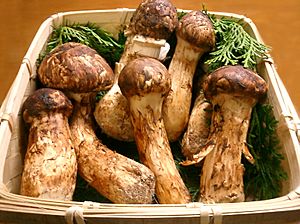Matsutake facts for kids
Quick facts for kids Matsutake |
|
|---|---|
 |
|
| Matsutake | |
| Conservation status | |
| Scientific classification | |
| Synonyms | |
|
| Tricholoma matsutake | |
|---|---|
| Mycological characteristics | |
| gills on hymenium | |
| cap is convex | |
| hymenium is adnexed | |
| stipe has a ring | |
| spore print is white | |
| ecology is mycorrhizal | |
| edibility: choice | |
| Matsutake | |||||
|---|---|---|---|---|---|
| Japanese name | |||||
| Kanji | 松茸 | ||||
| Hiragana | まつたけ | ||||
| Katakana | マツタケ | ||||
|
|||||
Matsutake (Japanese: 松茸/マツタケ), also known as Tricholoma matsutake, is a special kind of mushroom. People love to eat it because it tastes and smells unique. This mushroom grows in places like East Asia, Europe, and North America. It is very popular in Japanese cooking.
Contents
What's in a Name?
The name matsutake comes from the Japanese language. It has been used since the late 1800s. In Japanese, matsu means "pine tree" and take means "mushroom." So, Matsutake literally means "pine mushroom."
Where Matsutake Grows
Matsutake mushrooms grow in many parts of the world. You can find them in East Asia, like Japan and Korea. They also grow in parts of Southeast Asia, such as Bhutan and Laos. In Europe, they are found in countries like Estonia, Finland, Norway, Poland, and Sweden. On the Pacific coasts of Canada and the United States, you can also find them.
These mushrooms grow underground, hidden under leaves and other plant bits on the forest floor. They have a special partnership with tree roots. This partnership is called a symbiotic relationship. It means both the mushroom and the tree help each other. In Japan and Korea, Matsutake mushrooms often grow with a type of pine tree called Pinus densiflora.
Mushrooms That Look Like Matsutake
In Japan, there are a few mushrooms that look a lot like the real Matsutake. These include Tricholoma bakamatsutake, which means "stupid matsutake." There's also Tricholoma fulvocastaneum, called "fake matsutake." Another one is Tricholoma robustum, or "imitation of matsutake."
Out of these, only the "stupid matsutake" (T. bakamatsutake) tastes similar to the real one. The "stupid matsutake" and "fake matsutake" grow in forests with oak trees. But the "imitation of matsutake" grows in the same pine forests as the true Matsutake.
In North America, especially in the Pacific Northwest, you can find Tricholoma murrillianum. This mushroom grows in conifer forests with trees like western hemlock and Douglas fir. In California, it can also be found near hardwood trees such as Tanoak and Madrone. In northeastern North America, a similar mushroom called Tricholoma magnivelare often grows in Jack pine forests. Scientists have found that Tricholoma nauseosum is actually the same species as T. matsutake.
Why Matsutake Is So Expensive
Matsutake mushrooms are very hard to find. They need special conditions to grow, and the right forests are rare. Also, wild animals like squirrels and deer love to eat them. This means there's a lot of competition for the mushrooms, which only grow once a year.
In Japan, the amount of Matsutake grown has dropped a lot in the last 50 years. This is because of a tiny worm called a nematode (Bursaphelenchus xylophilus). This worm kills pine trees, which are important for Matsutake to grow. Now, Japan gets most of its Matsutake from other countries. These include China, Korea, the Pacific Northwest, British Columbia, and northern Europe.
Because they are so rare and special, Matsutake mushrooms can be very expensive. The price depends on how good they are, how many are available, and where they come from. At the start of the season, Matsutake from Japan can cost as much as $1,000 for one kilogram! Imported Matsutake usually costs around $90 per kilogram.
See also
 In Spanish: Tricholoma matsutake para niños
In Spanish: Tricholoma matsutake para niños


